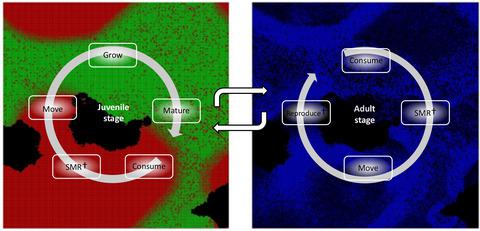当前位置:
X-MOL 学术
›
Funct. Ecol.
›
论文详情
Our official English website, www.x-mol.net, welcomes your
feedback! (Note: you will need to create a separate account there.)
Habitat loss and fragmentation increase realized predator‐prey body size ratios
Functional Ecology ( IF 4.6 ) Pub Date : 2019-11-07 , DOI: 10.1111/1365-2435.13472 Jasmijn Hillaert 1 , Martijn L. Vandegehuchte 1 , Thomas Hovestadt 2 , Dries Bonte 1
Functional Ecology ( IF 4.6 ) Pub Date : 2019-11-07 , DOI: 10.1111/1365-2435.13472 Jasmijn Hillaert 1 , Martijn L. Vandegehuchte 1 , Thomas Hovestadt 2 , Dries Bonte 1
Affiliation

|
In the absence of predators, habitat fragmentation favours large body sizes to facilitate gap crossing. The size of primary consumers is, however, also shaped by top-down effects as predators select prey of a certain size. Therefore, higher trophic levels should be taken into consideration when studying the effect of habitat loss and fragmentation on size distributions of herbivores. We built a model to study the effect of habitat loss and fragmentation within a tri-trophic food chain. Body size is directly linked to movement capacity and metabolic processes and considered as a master trait under selection. We show that basal resources accumulate locally if a predator causes top-down control of the herbivore. Due to this increasing spatiotemporal variability in resource availability, larger herbivores are selected than in scenarios without predator as they are able to move further. As predators cause herbivores to be intrinsically much larger than the optimal sizes selected by habitat fragmentation in the absence of predators, habitat fragmentation is no longer a significant driver of herbivore size. However, there is selection for increased predator size with habitat fragmentation as herbivores become less abundant, hence favouring gap-crossing ability of the predator. Since herbivore and predator body size respond differently to habitat loss and fragmentation, realized predator-herbivore body size ratios increase along this fragmentation gradient. Our model demonstrates how feedbacks between the abundance, body size and mobility of predators and prey ultimately determine body size distributions in food webs. These new insights shed light on the impact of habitat destruction and fragmentation on overall food web structure. A free Plain Language Summary can be found within the Supporting Information of this article.
中文翻译:

栖息地丧失和破碎化增加了实现的捕食者-猎物体型比
在没有捕食者的情况下,栖息地破碎化有利于大体型以促进间隙穿越。然而,当捕食者选择一定大小的猎物时,主要消费者的规模也受到自上而下的影响。因此,在研究栖息地丧失和破碎化对食草动物体型分布的影响时,应考虑更高的营养水平。我们建立了一个模型来研究三营养食物链中栖息地丧失和破碎化的影响。体型与运动能力和代谢过程直接相关,并被视为选择的主要特征。我们表明,如果捕食者导致对食草动物的自上而下控制,基础资源就会在当地积累。由于资源可用性的这种不断增加的时空变异性,与没有捕食者的情况相比,选择更大的食草动物,因为它们能够移动得更远。由于捕食者导致食草动物本质上比没有捕食者的栖息地破碎化选择的最佳尺寸大得多,栖息地破碎化不再是食草动物尺寸的重要驱动因素。然而,由于食草动物变得不那么丰富,因此有利于捕食者的跨越间隙的能力,随着栖息地破碎化,捕食者的体型增加。由于食草动物和捕食者的体型对栖息地丧失和破碎化的反应不同,实现的捕食者-食草动物体型比沿着这种破碎化梯度增加。我们的模型展示了捕食者和猎物的丰度、体型和移动性之间的反馈如何最终决定食物网中的体型分布。这些新见解阐明了栖息地破坏和破碎化对整体食物网结构的影响。可以在本文的支持信息中找到免费的普通语言摘要。
更新日期:2019-11-07
中文翻译:

栖息地丧失和破碎化增加了实现的捕食者-猎物体型比
在没有捕食者的情况下,栖息地破碎化有利于大体型以促进间隙穿越。然而,当捕食者选择一定大小的猎物时,主要消费者的规模也受到自上而下的影响。因此,在研究栖息地丧失和破碎化对食草动物体型分布的影响时,应考虑更高的营养水平。我们建立了一个模型来研究三营养食物链中栖息地丧失和破碎化的影响。体型与运动能力和代谢过程直接相关,并被视为选择的主要特征。我们表明,如果捕食者导致对食草动物的自上而下控制,基础资源就会在当地积累。由于资源可用性的这种不断增加的时空变异性,与没有捕食者的情况相比,选择更大的食草动物,因为它们能够移动得更远。由于捕食者导致食草动物本质上比没有捕食者的栖息地破碎化选择的最佳尺寸大得多,栖息地破碎化不再是食草动物尺寸的重要驱动因素。然而,由于食草动物变得不那么丰富,因此有利于捕食者的跨越间隙的能力,随着栖息地破碎化,捕食者的体型增加。由于食草动物和捕食者的体型对栖息地丧失和破碎化的反应不同,实现的捕食者-食草动物体型比沿着这种破碎化梯度增加。我们的模型展示了捕食者和猎物的丰度、体型和移动性之间的反馈如何最终决定食物网中的体型分布。这些新见解阐明了栖息地破坏和破碎化对整体食物网结构的影响。可以在本文的支持信息中找到免费的普通语言摘要。











































 京公网安备 11010802027423号
京公网安备 11010802027423号